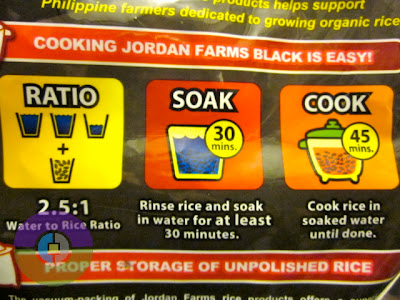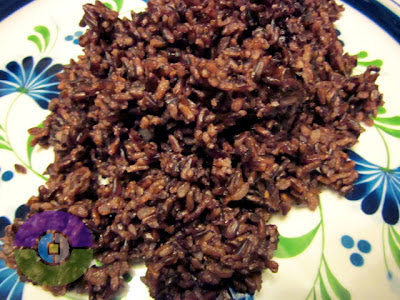When God created men, surely, He did not think of just one color. There's white, black, brown, red, and yellow-skinned people. What a colorful world, indeed! No dear, "smurfs", Kermit, and Barney are not human beings. So, blue, green, and purple are not colors for the human skin.
For the longest time, rice as the staple food for most Asians, comes in plain white. Not at all in sync with God's colorful world, is it? Recent developments in rice research however, have produced all sorts of colored rice. There's now brown, red, purple, and would you believe, pink rice? I have tried them all but the best for me is the "black" rice. Have you tried it yet?
Well, to be technical about it, all rice are actually white inside just like all humans have good souls inside them (terrible analogy, LOL!). What I meant was that rice actually has an outer covering (some sort of a shell) and skin. The outer covering is called the "husk" while the outer skin is known as the "bran". A "polished" rice means that the husk and bran are removed leaving the white "meat", so to speak. Thus, a polished rice is simply white rice. An "unpolished" rice has the husk removed but the bran remains. The bran is the rice's source of vitamins, minerals, and essential oils. The bran as the "skin" also provides the different colors (as different varieties of rice have different bran colors) which basically influences the taste and aroma.
The taste of black rice is exquisite! It's the best-tasting rice I ever had. I thought the fragrant jasmine short-grained sticky rice is already the best-tasting rice there is. Even though the colored ones are purported to be more nutritious and packed with several minerals and vitamins, I chose to eat the fragrant jasmine short-grained sticky rice (despite its long preparation time prior to cooking) because it's really tasty until of course I discovered the amazing black rice.
The preparation for the black rice before cooking is similar to that of the fragrant jasmine short-grained sticky rice. You have to soak the rice in water for at least 30 minutes before you cook it. Plain white rice does not require this process of soaking. Black rice however, I think requires the longest time to cook. Because the water to rice ratio is higher (i.e., 2.5 units of water to 1 unit of black rice), which means black rice requires more water, the cooking time is therefore, much longer. Plain rice even the sticky one requires a "1 to 1" ratio.
The packaging of the black rice (of the one I bought) indicates that the black rice was organically grown. My friend told me that this particular kind of organic rice is grown in the northern mountainous part of the Philippines (i.e., Ifugao region) where the rice requires a certain type of soil, climate, and altitude. (I really don't know where he got the info but he said that he watched it from a documentary on TV.) For every purchase of the rice according to the packaging, support for the farmers of the farm producing these organic rice are given. In whatever form or term wasn't mentioned in the packaging but hey, it's nice to know that I was indirectly helping out the farmers.
(If you want some more information about the colored-rice, you can visit the website of the company that packs and distributes these types of rice. It's at www.sunnywoodrice.com.)












A Healthy Eating plan Emphasizes fruits, vegetables, whole grains, and fat-free or low-fat milk and milk products, Includes lean meats, poultry, fish, beans, eggs, and nuts Healthy Eating
ReplyDelete